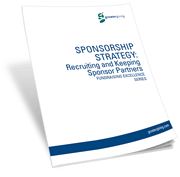
 This post is the fifth in a series designed to open you up to a new way of viewing sponsors and their role within your nonprofit’s overall strategy. These posts are based on the “Sponsorship Strategy: Recruiting and Keeping Sponsor Partners” eBook from the Greater Giving Fundraising Excellence Series. Each new post focuses on a different part of your sponsor strategy and how best to leverage your value for the greatest mutual benefit. View all released series articles—Sponsorship Strategies
This post is the fifth in a series designed to open you up to a new way of viewing sponsors and their role within your nonprofit’s overall strategy. These posts are based on the “Sponsorship Strategy: Recruiting and Keeping Sponsor Partners” eBook from the Greater Giving Fundraising Excellence Series. Each new post focuses on a different part of your sponsor strategy and how best to leverage your value for the greatest mutual benefit. View all released series articles—Sponsorship StrategiesLast time I wrote about framing your ask in terms of what you can offer to a potential sponsor, instead of the other way around. But now it’s time to make that concrete; to dig into assets you don’t even know you have and pry out what your nonprofit has to offer a potential sponsor that nobody else does.
Hint: it’s more than what you think you have!
What can you realistically offer?
The easy fish to put into your pitch are your sheer numbers. You’ve already done the hard work of growing your network, building an audience of people who read your emails and attend your annual events.
Think about everything your organization does each year—your annual gala, your walks, your a-thons and your big volunteer projects. How many people attend each one? What opportunities do these events have to offer potential sponsors, like a sampling table at your annual walk, or a booth at your big gala? The more ways you can offer to get your sponsor in front of more people, outside traditional marketing outreach channels, the better.
Take a look at your raw audience numbers, too. How many people do you have on your snail mail list? Your email list? Your social media accounts? These are all eyes a potential sponsor could get in front of. Give a general idea of who they can reach with their sponsorship, and how many.
Then drill down into the average age of your audience, their interests, favorite kinds of items at events, any demographic information you’ve been able to collect about your supporters over the years. These are the kinds of things sponsors find interesting and useful in planning a marketing strategy.
Why should they sponsor YOU, and not another similar organization?
Previously, you’ve done a deep dive into your sponsor’s mission, their goals, their dreams—now it’s time to do it for yourself.
Ask yourself this question:
Why should a potential sponsor choose you?
- What completely unique things does your organization have to offer? Multiple organizations could be competing for limited sponsorship dollars. You’ll need to dig into what makes you stand out. Maybe there are multiple nonprofits helping the community homeless, but only yours offers a program providing assistance for job interviews.
- Is there something about you that’s especially marketable? Your look, your impressive speed of growth, or any awards you’ve received within the community that shows why you’re the most worthy candidate?
- Don’t forget the power of the personal and emotional appeal. You’ve spent a lot of time listening to your sponsor about their goals and their dreams. How do your missions align? In what ways are you trying to accomplish the same things? How does a partnership with you make those dreams a reality? This isn’t just a practical partnership you’re offering, but a philosophical one, too. You share a vision, and a sponsorship helps both of you achieve it.
What is your human resource value?
As a nonprofit you’ve developed a special set of skills, gained and fostered access to certain lucrative channels, and developed professional and political connections that nobody else has. Capitalize on them! You’ve asked your potential sponsor all kinds of questions about what they want to accomplish. Who do you know, and what do you know, that can help make it reality?
Maybe one of your board members can get season tickets every year for a local sports team—who happens to be a favorite at the business you’re courting for a sponsorship. You always have the pass up for sale in your annual auction, and a front row seat in the ballroom is a great way to bid on and win it.
Perhaps you or someone on your team can offer marketing expertise, or a unique and valuable skill, that would help your sponsor accomplish some of their goals. Maybe a person of interest to your potential sponsor also attends your annual event, or sits on your board. Evaluate all of your human resources and what they have to offer that might be valuable.
Stand out for that “Yes!”
When you’re developing your pitch, every component that makes your organization unique will help you stand out from the crowd. These are just more reasons why you two would make such a great match!
